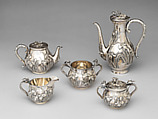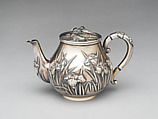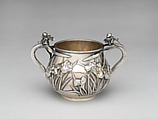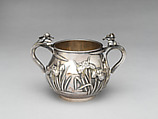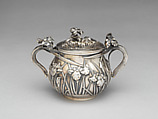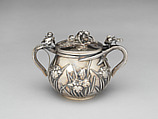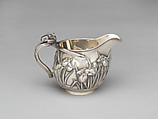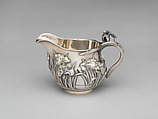Five-piece silver tea and coffee service with iris patterns
Not on view
This five-piece sterling silver set, comprising a coffee pot, a tea pot, a covered sugar bowl, a double wall creamer, and a wastewater bowl is an example of hybrid metalworks made in the Meiji period (1868–1912), bringing together Western shapes and functions with Japanese patterns and techniques. Each piece of the set is elaborately chased in a complex design of blossoming irises in water reeds with rippling water. The handles, spouts and lids are also embellished with iris blossoms. The theme of irises growing along a stream was derived from an ancient poem, Yatsuhashi from the Tales of Ise (Ise monogatari), referring to the poet Ariwara no Narihira and his companions on a long journey stopping to rest at Mikawa beside a riverbank abloom with irises. An old rustic bridge of eight wooden planks reminded the weary travelers of a similar spot in Kyoto, for which they expressed their yearning in a series of nostalgic verses. This favored Japanese pattern became popular as an Art Nouveau-style motif in the West. Novelty and freshness were keenly sought design attributes in the wake of Western historic revivals that had reached an apex by the 1876 Centennial Exhibition in Philadelphia. The array of Japanese wares at the exhibition was a catalyst in fueling the fashion in the United States for Japanese design, which played a significant part in the development of the American Aesthetic Movement, which spanned the 1870s to 1880s. Endeavoring to reform the contemporary taste, the Aesthetic Movement sought new sources of inspiration. Leading silver firms, such as the Gorham Manufacturing Company and Tiffany & Co., adopted and adapted Japanese aesthetics and techniques to create visually stunning works, which garnered worldwide recognition.
This image cannot be enlarged, viewed at full screen, or downloaded.
This artwork is meant to be viewed from right to left. Scroll left to view more.
